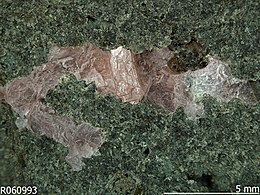Our website is made possible by displaying online advertisements to our visitors.
Please consider supporting us by disabling your ad blocker.
Lanthanite
| Lanthanite-(La), Lanthanite-(Nd), Lanthanite-(Ce) | |
|---|---|
 Lanthanite-(Nd) from Mitsukoshi, Hizen-cho, Karatsu City, Saga Prefecture, Japan. | |
| General | |
| Category | Carbonate minerals |
| Formula (repeating unit) | (REE)2(CO3)3·8(H2O) |
| IMA symbol | Ltn[1] |
| Strunz classification | 5.CC.25 |
| Dana classification | (La): 15.04.02.01 (Nd): 15.04.02.02 (Ce): 15.04.02.03 |
| Crystal system | Orthorhombic |
| Crystal class | Dipyramidal (mmm) H-M symbol: (2/m 2/m 2/m) |
| Space group | Pbnb |
| Unit cell | a = 9.476(4)-9.483(6) b = 16.940(8)-16.938(11) c = 8.942(4)-8.965(3) [Å], Z = 4 |
| Identification | |
| Color | Pale pink to purple |
| Crystal habit | Platy |
| Twinning | Common on {101} |
| Cleavage | Micaceous, perfect on {101} |
| Fracture | Uneven |
| Tenacity | Sectile |
| Mohs scale hardness | 2.5 |
| Luster | Vitreous to pearly |
| Streak | White |
| Density | 2.78-2.84 (measured), 2.79-2.816 (calculated) |
| Optical properties | Biaxial (-) |
| 2V angle | 58-61° (measured), 60-63.5° (calculated) |
| References | [2] |
Lanthanites are a group of isostructural rare earth element (REE) carbonate minerals. This group comprises the minerals lanthanite-(La),[3][4] lanthanite-(Ce),[5] and lanthanite-(Nd).[6] This mineral group has the general chemical formula of (REE)2(CO3)3·8(H2O). Lanthanites include La, Ce, and Nd as major elements and often contain subordinate amounts of other REEs including praseodymium (Pr), samarium (Sm), europium (Eu) and dysprosium (Dy).[7] The lanthanite crystal structure consists of layers of 10-fold coordinated REE-oxygen (O) polyhedra and carbonate (CO32−) groups connected by hydrogen bonds to interlayer water molecules, forming a highly hydrated structure.[8]
- ^ Warr, L.N. (2021). "IMA–CNMNC approved mineral symbols". Mineralogical Magazine. 85 (3): 291–320. Bibcode:2021MinM...85..291W. doi:10.1180/mgm.2021.43. S2CID 235729616.
- ^ Lanthanite on Mindat
- ^ Haidinger W (1845) Zweite Klasse: Geogenide. II. Ordnung. Baryte. III. Cerebaryt. Lanthanit., in Handbuch der Bestimmenden Mineralogie, Bei Braumüller and Seidel (Wien) 499-506.
- ^ Nickel E H, Mandarino J A (1987) Procedures involving the IMA Commission on New Minerals and Mineral Names and guidelines on mineral nomenclature, American Mineralogist 72, 1031-1042.
- ^ Bevins R E, Rowbotham G, Stephens F S, Turgoose S, Williams P A (1985) Lanthanite-(Ce), (Ce,La,Nd)2(CO3)3·8H2O, a new mineral from Wales, U.K.. American Mineralogist 70, 411-413.
- ^ Roberts A C, Chao G Y, Cesbron F (1980) Lanthanite-(Nd), a new mineral from Curitiba, Parana, Brazil, Geological Survey of Canada Paper 80-1C, 141-142.
- ^ The Canadian Mineralogist 45 (2007) 1389-1396.
- ^ Morrison, S. M., Andrade, M. B., Wenz, M. D., Domanik, K. J., & Downs, R. T. (2013). Lanthanite-(Nd), Nd2 (CO3) 3.8 H2O. Acta Crystallographica Section E: Structure Reports Online, 69(3), i15-i16. doi:10.1107/S1600536813003164
Previous Page Next Page


